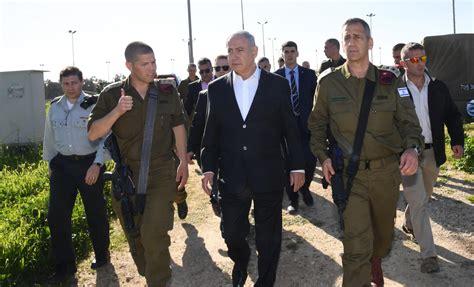
Netanyahu: Israel ordered IDF to begin operating in Gaza’s Rafah
Prime Minister Benjamin Netanyahu made the most direct statement to date about the IDF being ready to act in Rafah on Wednesday night.
“We have instructed the IDF to also take action in Rafah and in the two camps in the center [of Gaza], the last remaining strongholds of Hamas. The IDF will facilitate the civilian population to move away through a humanitarian corridor according to international law,” said Netanyahu.
Until now, Netanyahu, Defense Minister Yoav Gallant, and top IDF officials have repeated generic threats about eventually going into Rafah, but they had all refrained from any concrete statements, such as those made by Netanyahu.
However, multiple defense sources threw cold water on the idea that any major change in policy or imminent invasion of Rafah was taking place.
Still, it seemed possible that there had been some forward movement toward taking action in Rafah, given that defense sources did not have an alternate explanation of Netanyahu’s comments, and sources close to the prime minister did not back down.
The military further noted that in response to the attacks from Lebanon towards Mount Dov, Shetula, Goren, and Margaliot in multiple rounds on Wednesday, IDF artillery counterattacked the sources of the fire.
The IDF Home Front Command did not report any rocket sirens from Hezbollah’s attacks.
It was unclear why, though anti-tank missiles usually do not trigger sirens, if the attacks were anti-tank missiles, and some rockets do not, if they are not expected to hit civilian areas.
Hamas did not fire any rockets on Wednesday or Tuesday, with the last rocket fired on Monday being the only rocket fired by the terror group since Saturday.
The last salvo of Hamas rockets was on January 29 and the last salvo before that was in early January.
Even since December 8, most days Hamas has either not fired rockets or fired rockets in single digits, and with only a few exceptions, only short range rockets at the South.
At this point, IDF sources have suggested to the Jerusalem Post that Hamas’s leadership and the hostages may be in Rafah, hiding among around 1.5 million Palestinian civilians, while some may also be in a part of central Gaza which the IDF has not finished with.
However, it is highly complicated to go into Rafah due to the sensitivities of the border with Egypt and the danger to the immense civilian population there.
Separately, the IDF announced on Wednesday that it found a second round of Hamas hostage cages underground in Khan Yunis.
The announcement followed an earlier IDF announcement of a similar finding of hostage cages on January 20.
In this case, there were cages for 12 hostages, nine of which are still held by Hamas, and three of which were returned to Israel during the November 23-30 hostage exchange deal.
For both discoveries, the cages were only found after delving deep into a very extended tunnel with a variety of defenses until arriving at an unusually large space with many Hamas terror management functions, including the cages for the hostages.
IDF intelligence estimates that Gaza Chief Yahya Sinwar and other top Hamas leaders used these hostages as human shields to protect them from IDF attacks.
Millions of shekels were invested in these special underground spaces to outfit them with unique capabilities, including the cages, and to manage the war with Israel.
IDF intelligence is unsure how many more such spaces there may be, though at this point, the IDF has said it has nearly achieved operational control of Khan Yunis and it had already achieved such control in Gaza City over a month ago.
Also, St.-Sgt. Hanan Drori Hanan Drori of Psagot was announced as a fallen soldier on Wednesday morning by the Binyamin Regional Council. He served in the 551st (Res.) Battalion of the Paratroopers Brigade.
According to the Council’s statement, Drori was wounded over two months ago while serving in Gaza but has now succumbed to his wounds. He reportedly suffered from a medical fungus that caused an infection.
Drori, who was 26, is survived by his parents and three brothers and was reportedly about to get engaged.
“I knew Hanan as a dear neighbor,” Binyamin Regional Council head Israel Ganz said. “We have lost a beautiful man with a sense of humor and kindness. A smart and brilliant guy. We embrace the whole family and the dear parents Tali and Roni.”
Drori is the third resident of Psagot to be killed since the war against Hamas began.
In the North, an Israeli Air Force fighter jet attacked a Hezbollah military structure in the region of Marwahin, IDF Spokesperson’s Unit reported earlier Wednesday.
Late Wednesday night, the IDF attacked the al-Hiam area, including Hezbollah lookout posts.
The IDF went out of the way to designate al-Hiam as a lead problem village abused by Hezbollah, saying that one-sixth of the rocket or anti-tank missile attacks from Lebanon had come from there.
In addition, on Tuesday night, IDF warplanes targeted Hezbollah military infrastructure in the area of the village of Bani Hiyan.
Source » jpost.com





